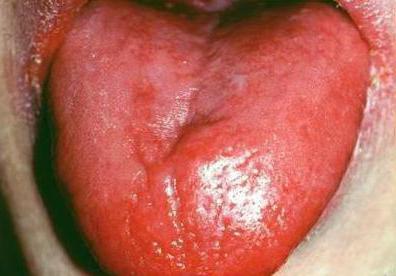Plummer-Winson syndrome is a systemic disease. Its main manifestations are a decrease in hemoglobin, associated with a lack of iron, atrophy of the mucous membrane of the digestive system and impaired swallowing. In addition, in patients there are deviations from other organs and systems. Patients complain of poor condition of nails and skin, inflammation of the tongue, visual impairment. This is a complex pathology that does not respond well to therapy. The disease occurs mainly in women aged 20 to 50 years.
Etiology
Medical studies have not established the exact cause of Plummer-Winson syndrome. It is assumed that this pathology occurs due to the lack of enzymes involved in the metabolism of iron. As a result, a deficiency of vitamin B2 and B9 (riboflavin and folic acid) is formed. And also the body begins to miss iron. The lack of this element leads to anemia, muscle weakness involved in the act of swallowing, pathological changes in the epithelium of the esophagus and stomach.
Other causes of the development of the disease can be poor nutrition, in which the diet does not contain enough foods with iron, as well as a genetic predisposition.
Some medical scientists believe that this pathology is associated with autoimmune disorders. Often, Plummer-Winson syndrome occurs in patients with rheumatoid arthritis, thyroiditis, and intolerance to gluten protein.
Symptoms
At the beginning of the disease, patients complain of weakness, increased fatigue, and fatigue. They have a rapid heartbeat. These are the first signs of iron deficiency anemia. Next, systemic changes in many organs begin, which is expressed in the following symptoms:
- It becomes difficult for a person to swallow food, while pain in the esophagus occurs. At first, the patient cannot eat only rough food. But then difficulties arise even when swallowing soft foods and liquids.
- Due to atrophy of the mucosa, damage to the upper part of the esophagus occurs. Then gastritis and enteritis develop.
- The nails become thinner and become concave.
- The skin of the face becomes greasy, inflamed and covered with acne.
- Inflamed cracks can be seen in the corners of the mouth.
- The lips become inflamed, redden and flaky.
- Iron deficiency leads to a change in the color of the eye proteins. Sclera acquire a bluish or bluish tint. The patient begins to see worse in poor lighting or in the dark. Eye diseases may occur: keratitis, conjunctivitis, blepharitis.
- Urine acquires a reddish color.
- Changes in smell and taste are characteristic. The patient becomes addicted to unpleasant odors and spicy, salty or sour foods.
- Tongue turns red, inflamed. Its surface is smoothed and looks varnished. This symptom can be found in 10% of patients with Plummer-Winson syndrome. A photo of the patient’s tongue can be seen below.

If such symptoms are found, consult a doctor immediately. Hematologists and gastroenterologists are involved in the treatment of this pathology. The disease is dangerous with complications. Atrophic changes in the mucous membrane of the stomach and esophagus often lead to the formation of malignant tumors on these organs.
According to ICD-10, Plummer-Winson syndrome is designated under the code D50.1, as one of the types of iron deficiency anemia. Another name for this disease is sideropenic dysphagia.
Diagnostics
A preliminary diagnosis can be made on the basis of patient complaints and characteristic changes in the skin, nails, tongue. This allows the doctor to suspect iron deficiency anemia in the patient. To clarify the nature of the pathology, it is necessary to examine the blood picture and the condition of the esophagus.
A detailed hematological analysis is prescribed . In patients with Plummer-Winson syndrome, reduced hemoglobin, a change in the correct shape and size of red blood cells, and flattening of blood cells are detected. In addition, you should pass an analysis for the content of ferritin. In patients, this indicator is usually sharply reduced.
An important role in the diagnosis of Plummer-Winson syndrome is played by an examination of the esophagus. It is necessary to do an x-ray of this organ, as well as esophagoscopy. Patients have a thickening and keratinization of the epithelium of the esophagus. On x-rays, you can see a picture in the form of a "web" in the upper part of the organ.
Treatment
Patients with Plummer-Winson syndrome are prescribed iron preparations, drugs containing riboflavin, folic acid, lactoflavin and pyridoxine. Patients need to take medications that improve gastric secretion and digestion. A high protein and vitamin B6 diet is recommended. It is useful for patients to include dairy products, liver, meat, eggs, vegetables in the diet.
Forecast
In the early stages of Plummer-Winson syndrome, timely treatment and diet will help achieve long-term remission and improve well-being. However, with severe symptoms, the prognosis of the disease is poor. In advanced cases, it is almost impossible to cure this pathology.
Patients suffering from this syndrome should periodically undergo a thorough gastroenterological and oncological examination, since atrophic changes in the esophagus are considered a precancerous condition.
Prevention
Specific prophylaxis of Plummer-Winson syndrome is currently not developed, since the exact causes of the pathology have not been established. However, you can reduce the likelihood of developing this disease. It is necessary to include foods rich in iron and B vitamins in the diet, lead an active lifestyle with reasonable physical exertion, and systematically monitor hemoglobin levels. All this will help minimize the risk of iron deficiency anemia.